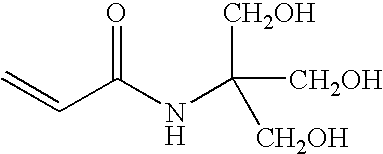Composition and method for preparing novel cationic thickeners
a technology of cationic thickeners and cationic ions, applied in the field of new polymers, can solve the problems of fluctuating quality and price, and lose the thickening power of formulations high in electrolytes, and achieve the effect of reducing the number of cationic thickeners
- Summary
- Abstract
- Description
- Claims
- Application Information
AI Technical Summary
Benefits of technology
Problems solved by technology
Method used
Image
Examples
example 1
Self-reversible Invert Latex of the Copolymer: AM / APTAC / LA(4EO) (84.7 / 14.9 / 0.4) Crosslinked with MBA
[0082]The following are loaded into a beaker, with stirring:[0083]164.4 g of deionized water,[0084]362.1 g of a commercial solution containing 50% of acrylamide (AM),[0085]123.9 g of a commercial solution containing 75% of acrylamidopropyltrimethylammonium chloride (APTAC)[0086]0.070 g of methylene bisacrylamide (MBA),[0087]0.45 g of a commercial aqueous solution containing 40% of the sodium salt of diethylene-triaminepentaacetic acid.
[0088]An oily phase is prepared by successively mixing:[0089]259 g of isohexadecane,[0090]20 g of sorbitan isostearate (MONTANE™ 70),[0091]5 g of HYPERMER™ 2296 (Uniquema),[0092]5 g of tetraethoxylated lauryl acrylate [LA(4EO)],[0093]0.1 g of azobis(isobutyronitrile) (AIBN).
[0094]The aqueous phase is gradually incorporated into the organic phase and then subjected to vigorous mechanical stirring by means of an ULTRA-TURRAX™ type turbine mixer in order to...
example 2
Self-reversible Invert Latex of the Copolymer: Noncrosslinked AM / APTAC / THAM / LA(4EO) (77.7 / 14.9 / 7.0 / 0.4)
[0102]The following are loaded into a beaker, with stirring:[0103]157.6 g of deionized water,[0104]332.3 g of a commercial solution containing 50% of acrylamide (AM),[0105]123.9 g of a commercial solution containing 75% of acrylamidopropyltrimethylammonium chloride (APTAC)[0106]36.8 g of tris(hydroxymethyl)acrylamidomethane (THAM),[0107]0.45 g of a commercial aqueous solution containing 40% of the sodium salt of diethylene-triaminepentaacetic acid.
[0108]An oily phase is prepared by successively mixing:[0109]259 g of isohexadecane,[0110]20 g of sorbitan isostearate (MONTANE™ 70),[0111]5 g of HYPERMER™ 2296 (Uniquema),[0112]5 g of tetraethoxylated lauryl acrylate [LA(4EO)],[0113]0.1 g of azobis(isobutyronitrile) (AIBN).
[0114]The procedure is then carried out according to a procedure identical to that of Example 1 and the desired self-reversible invert latex is obtained.
[0115]Analysis...
example 3
Self-reversible Invert Latex of the Copolymer: Noncrosslinked AM / APTAC / THAM / LA(4EO) (72.7 / 19.9 / 7.0 / 0.4)
[0121]The following are loaded into a beaker, with stirring:[0122]137.5 g of deionized water,[0123]311 g of a commercial solution containing 50% of acrylamide (AM),[0124]165.2 g of a commercial solution containing 75% by weight of acrylamidopropyltrimethylammonium chloride (APTAC)[0125]36.8 g of tris(hydroxymethyl)acrylamidomethane (THAM),[0126]0.45 g of a commercial aqueous solution containing 40% of the sodium salt of diethylene-triaminepentaacetic acid.
[0127]An oily phase is prepared by successively mixing:[0128]259 g of isohexadecane,[0129]20 g of sorbitan isostearate (MONTANE™ 70),[0130]5 g of HYPERMER™ 2296 (Uniquema),[0131]5 g of tetraethoxylated lauryl acrylate [LA(4EO)],[0132]0.1 g of azobis(isobutyronitrile) (AIBN).
[0133]The procedure is then carried out according to a procedure identical to that of Example 1 and the desired self-reversible invert latex is obtained.
[0134]...
PUM
| Property | Measurement | Unit |
|---|---|---|
| Fraction | aaaaa | aaaaa |
| Fraction | aaaaa | aaaaa |
| Fraction | aaaaa | aaaaa |
Abstract
Description
Claims
Application Information
 Login to View More
Login to View More - R&D
- Intellectual Property
- Life Sciences
- Materials
- Tech Scout
- Unparalleled Data Quality
- Higher Quality Content
- 60% Fewer Hallucinations
Browse by: Latest US Patents, China's latest patents, Technical Efficacy Thesaurus, Application Domain, Technology Topic, Popular Technical Reports.
© 2025 PatSnap. All rights reserved.Legal|Privacy policy|Modern Slavery Act Transparency Statement|Sitemap|About US| Contact US: help@patsnap.com

